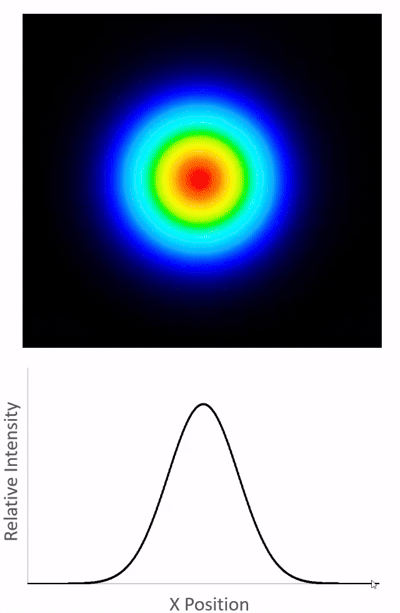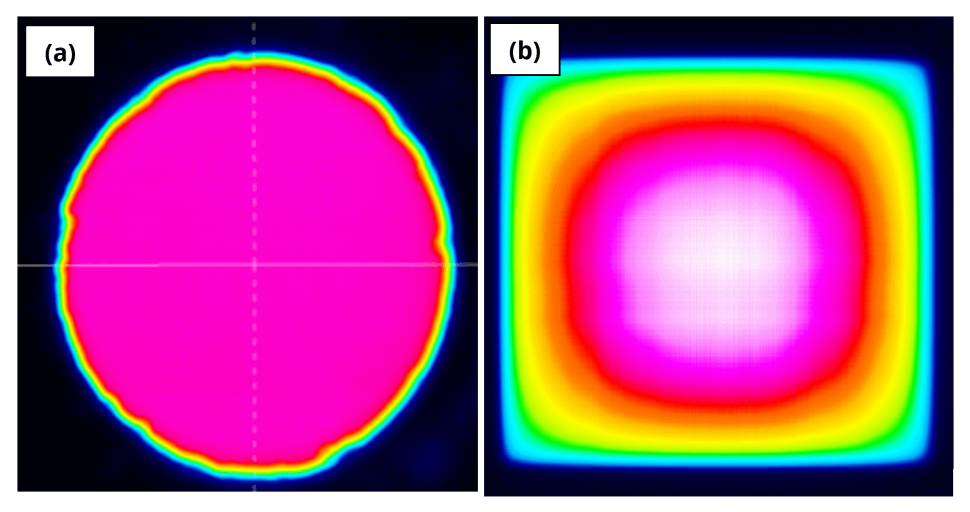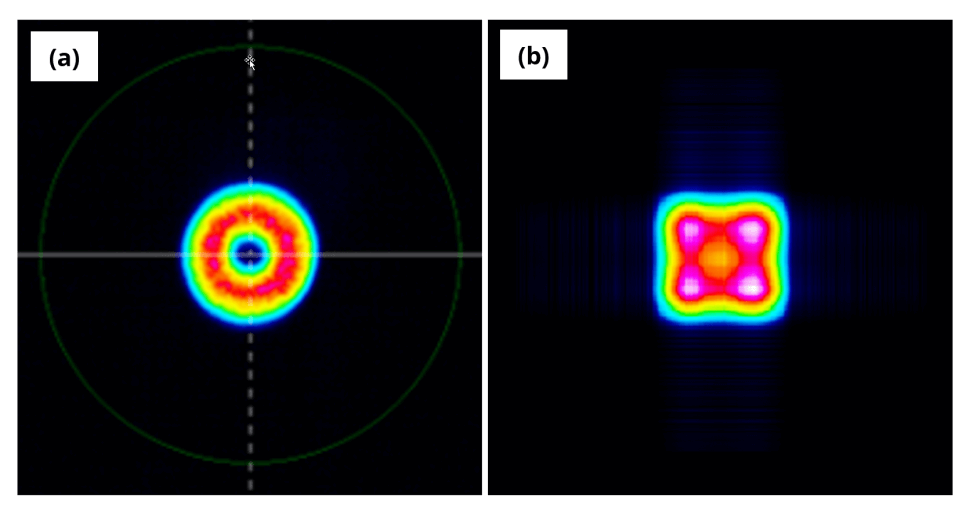True 2D Beam Profiling: Advantages of Camera Profiling Systems
Beam Profiling Concepts | November 14, 2025
DataRay offers state-of-the-art profiling systems that fall within two major categories: scanning slit (like our Beam’R2 and BeamMap2) and camera profilers (like our WinCamD, BladeCam2, and TaperCamD series). These profilers utilize fundamentally different measurement techniques to deliver distinct advantages, discussed in our previous blog post, Scanning Slits vs. Cameras. In this article, we dive deeper into the differences between the two and highlight situations in which a camera profiler is a more suitable choice.
Scanning Slit Profilers
Scanning slit profilers operate by mechanically moving a slit-shaped aperture across a beam. The light passing through the slit is collected by a single-element photodetector and used to construct a 1D profile. A simplified animation of this process is shown in Figure 1.
Since all the light passing through a slit at a given slit position provides a single relative intensity data point, the 1D profiles generated by scanning slit devices are inherently integrated (i.e. summed). The process is repeated for both X and Y directions to generate two 1D integrated beam profiles. While these profiles are displayed in the DataRay software as 1D and 2D plots, these are not true 1D or 2D beam profiles. Rather, they are integrated 1D profiles and a 2D visual representation of these integrated 1D profiles.

Camera Profilers
Camera profilers are conceptually simple. A beam is aimed at a monochromatic camera sensor and each pixel measures the relative intensity of the light at that pixel’s specific XY location. The image generated from this array of pixels provides a true, pixel-by-pixel, 2D representation of the beam intensity at a single plane as shown in Figure 2. A line of pixels can be read out anywhere across this 2D image to produce a true 1D profile. Since every relative intensity data point is generated from a single pixel, these 1D profiles are not integrated or summed like those generated by a scanning slit profiler.

Why are True 1D and 2D Profiles Important?
Since scanning slit profilers do not produce true 1D and 2D beam profiles, they can misrepresent beams that are non-Gaussian or elliptical. For Gaussian and circularly symmetric (i.e. non-elliptical) beams, scanning slit profilers still provide accurate results. In the next section, all 2Wua and 2Wva values are 1/e2 diameters while 2Wub and 2Wvb values are FWHM diameters. All camera 1D profiles are captured along the major and minor axis, while scanning slit results are shown along the physical X and Y axis of the profiler.
Elliptical Beams
If special care is not taken while profiling, scanning slit devices can misrepresent elliptical beams. Figure 3a shows a true 2D profile of an elliptical beam captured with a camera profiler. The major and minor 1/e2 diameters are 401.4 um and 204.3 um, respectively. This shows that the camera profiler accurately captures the ellipticity of the beam.
Figure 3b shows the same beam profiled by a scanning slit profiler. The major and minor 1/e2 diameters in this case are both measured as 317.1 um. The scanning slit profiler fails to identify this beam as elliptical.
As the slit moves across the beam in X and Y, the profiler records the amount of light passing through the entire slit, so the orientation of the beam is lost. It should be noted that if the X and Y axis of a scanning slit profiler is precisely aligned with the major and minor axis of the beam, a scanning slit profiler can accurately represent the ellipticity of the beam.

Homogenous Beams (Flat-Top, Top-Hat, etc.)
For some applications, it’s important to quantify the homogeneity of the beam. A flat-top beam profile captured with a camera is shown in Figure 4a. The corresponding 1D profiles from the camera are shown in Figure 5a. As seen in the 1D and 2D camera beam profiles, the beam intensity is relatively uniform, exhibiting a typical “top-hat” shape.
Figure 4b shows the 2D profile of the same beam captured by a scanning slit device. Figure 5b shows the 1D integrated/summed profiles from the same device. Both the 1D and 2D scanning slit profiles fail to capture the uniformity of the beam.
As the scanning slit crosses the beam, more and more light passes through the slit until it passes the center of the beam, producing a “dome” shape. It would be challenging to quantify the homogeneity of this beam using a scanning slit profiler. The 2D scanning slit profile also erroneously interprets the beam profile as a square shape.


Ring-Shaped Beams
Ring-shaped and ring-core structed beams are commonly found in laser welding and other advanced manufacturing processes. Figure 6a shows a true 2D beam profile of a ring-shaped beam captured from a camera. Figure 7a shows the corresponding 1D profiles. Note that both the 1D and 2D profiles accurately capture the dark hole in the center of the beam.
Figure 6b shows the 2D profile of the same beam captured by a scanning slit device. The integrated/summed 1D profiles from the same device are shown in Figure 7b. From this data, it would be difficult to determine if a dark hole exists in the center of the beam. Instead, only a drop in intensity near the center of the beam is observed.
As the slit passes through the center of the beam, light from the ring still passes through the edges of the slit. This prevents the scanning slit profiler from accurately identifying the dark hole in the center. Similar to the flattop case previously discussed in this article, the scanning slit profiler also erroneously represents the beam as a square shape instead of circular.


Conclusion
Since scanning slit profilers generate integrated/summed 1D profiles in X and Y, they can misrepresent non-Gaussian and elliptical beams. However, camera profilers, with their ability to generate true pixel-by-pixel 1D and 2D beam profiles, are better suited for characterizing complex or asymmetric beams while still providing excellent results for Gaussian and circularly symmetric beams. Not sure which option is best for you? Contact us — our team of beam profiling experts is here to help!
Related News
Video: Triggers and Exposure Settings
DataRay Software | October 17, 2025
The DataRay beam profiling software provides powerful state-of-the-art features to characterize your beams quickly and efficiently. Our team has developed a series of short videos to help explain and demonstrate key software functionality. This fourth video in the series focuses on trigger and exposure time settings...
